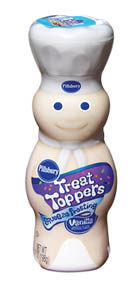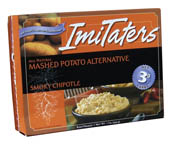
Dual-branding--Good or Bad?
Kraft Foods (Glenview, Ill.), along with other major companies in the food and beverage industry, has embraced low-carb products with a passion. Most every major consumer packaged goods company has launched a brand new line, extended existing lines or engaged in some creative co-branding.Kraft has co-branded its own brands with its new Carb Well brand. The Carb Well name conveys the low-carb formulation and specific positioning of the product. Marrying this name with the company's core brand serves to reinforce with the consumer what the product is, how it will perform and how reliable it is.
The strategy is smart in that once the low-carb craze dies away, the Carb Well brand can simply be taken off the existing products--no new brand name will be abandoned. However, it can potentially backfire because consumers may expect certain products (this Carb Well Balance Bar, for example) to taste just like its core brand, the Balance Bar. Only time is going to tell how well this will work. Stay tuned.
Too Bad It Doesn't Talk
There seems to be a resurgence in products for baking. The news, though, is that they all simplify baking even further for the consumer. One of the latest products launched is Pillsbury's (Minneapolis) Treat Toppers frosting. It comes in a squeeze bottle and is designed to be a decorating tool (consumers can squeeze out small amounts of frosting in order to make designs on a cake).
What makes the product particularly fun is that the bottle is shaped like the Pillsbury doughboy, and the frosting comes out of his head. The 7oz. squeeze bottle retails for $1.98, which is a bit pricey, but makes sense given the convenience the package offers.

A New Kind of Tea
Consumers have been introduced to green tea, flavored tea, herbal tea and, now, white tea. White tea quite often features the same type of tea leaves utilized in green and black teas, but they undergo less processing. As a result, they change color less and produce a paler drink.This lesser amount of processing yields a higher antioxidant content in the tea, some research shows. The products often are promoted as providing more significant health benefits than other types of tea.
Consumers pay for the advantage. Fuze Beverage LLC's (Englewood Cliffs, N.J.) 10oz. bottle of tea sells for about $1.99, a bit higher than other similar tea products on the market. The tea comes in four flavors: Blackberry, Tangerine, Raspberry and Key Lime.
Swimming to New Waters
Pepperidge Farm (Norwalk, Conn.) continues to extend its Goldfish products with new flavors and forms. In the last year or so, the company added large cheese and cracker sandwiches, as well as intensely flavored goldfish crackers. The newest addition is a multipack of Goldfish Sandwich Snackers. The boxes contain crackers sandwiched with cheese, peanut butter, or cheese crackers with peanut butter.
This new product comes in a carton with a pointed rather than a flat top, perhaps a bit reminiscent of a bakery package. And its intense Goldfish crackers come not in the usual paper “bags” we see for normal Goldfish, but in same-size packs that have metallized film packaging. This allows the company to better use intense colors and shiny textures to convey the “extreme” nature of the flavors.
One Potato, Two Potato…Cauliflower?
While the low-carb craze continues (albeit more slowly), we do see more products designed to appeal to that lifestyle. For those consumers who regret the loss of their mashed potatoes, companies like Heritage Family Specialty Foods (Grand Prairie, Texas) offer alternatives. ImiTaters is a package of frozen, mashed, seasoned cauliflower said to resemble mashed potatoes in both taste and texture. They are not cheap, though. A 1lb. frozen box retails for just over $5. The cauliflower is marketed specifically as a mashed potato alternative, and comes in flavors such as Smoky Chipotle, Savory Garlic and The Works.
Many companies with low-carb products will suffer once the trend fades, as their product brand names and positioning no longer will resonate with consumers. However, brands with this type of positioning may last longer, as the name easily is translatable to more mainstream diets.
GlobalTrends
Snacking on the go is not a new phenomenon in Japan: standing on a crowded platform, you are likely to come across a variety of people biting into the many different flavors of Pocky--plain chocolate, mousse milk tea or chocolate caramel, to name a few. For those of you not familiar with the product, Pocky is the Japanese equivalent of a Kit Kat. However, with a rise in mess-free, hands-free snacks on the go in recent years, the snacks market is changingThe pull-open Tropical Sorbet is typical of the new snack revolution and appeals to the Japanese obsession for everything that is convenient, compact and portable. The jelly (which turns into a sorbet when frozen) comes enclosed in a patent pending, crush-free plastic container. Japanese commuters can now sleep (standing up) in peace without worrying about their snacks getting crushed.
In Hong Kong, Swire Coca-Cola has introduced a new range under the Fanta brand. The Fanta Lactic beverages, available in two flavors, Plain Lactic and White Grape Lactic, are carbonated soft drinks with a milky flavor, packaged in 355ml aluminium cans, with cartoon cow characters and the traditional Fanta logo, presumably targeted to children.
Flavored milk-based drinks already are quite common, but this is one of the first examples of the reverse: carbonated drinks with milk flavor. The ingredients do not contain any milk, but the inclusion of flavorings and thickeners leads us to presume that these carbonated drinks have a thicker and richer texture than normal Fanta, possibly a milky or creamy texture with extra fizz.
Portability is a trend that has been present across most food categories. In the U.K., Unilever Bestfoods has extended its PG Tips brand with an on-the-go tea, comprising a cup with a PG Tips teabag threaded through the top of the cap. Consumers add hot water to the cup, add the cap and heat sleeve, and when the tea is ready to drink, just pull the teabag up into the cap, where it locks to prevent further brewing. This product is available to foodservice only, but has the potential to expand into the consumer market. Time-poor consumers might have the time to boil the kettle water, but don't have time to wait for the tea to brew and drink it at home.